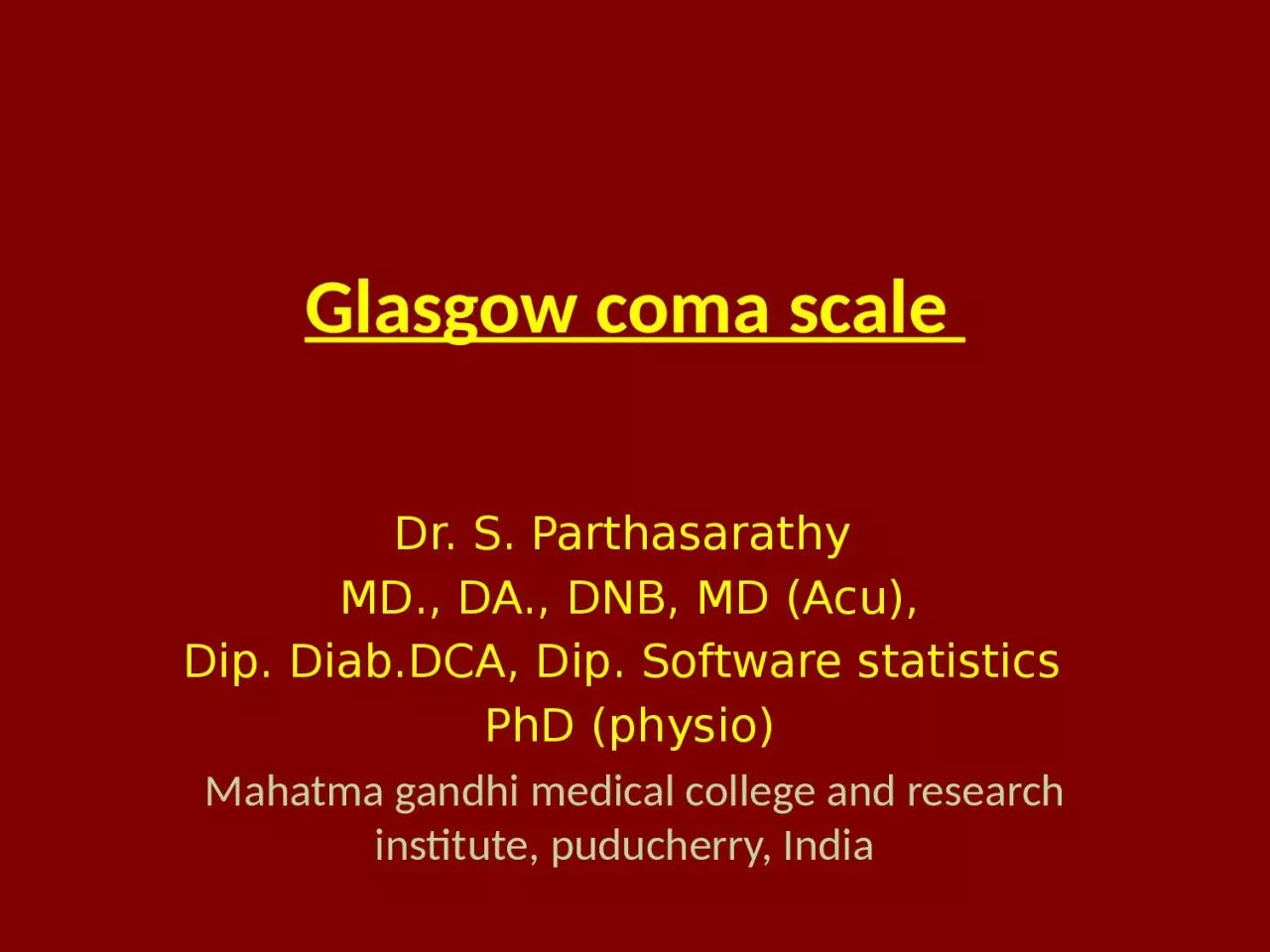

MD DA DNB MD Acu Dip DiabDCA Dip Software statistics PhD physio Mahatma gandhi medical college and research institute puducherry India Some history Teasdale and ID: 930775
Download Presentation The PPT/PDF document "Glasgow coma scale Dr. S. Parthasarathy" is the property of its rightful owner. Permission is granted to download and print the materials on this web site for personal, non-commercial use only, and to display it on your personal computer provided you do not modify the materials and that you retain all copyright notices contained in the materials. By downloading content from our website, you accept the terms of this agreement.
Slide1
Glasgow coma scale
Dr. S. Parthasarathy
MD., DA., DNB, MD (
Acu
),
Dip. Diab.DCA, Dip. Software statistics
PhD (
physio
)
Mahatma
gandhi
medical college and research institute,
puducherry
, India
Slide2Some history
Teasdale and
Jennett
in 1974
the Glasgow Coma Scale or GCS is a
neurological scale
that aims to give a reliable, objective way of recording the conscious state of a person for initial as well as subsequent assessment.
Slide3First use !!
as a method of describing states of impairment within the consciousness continuum
a quick, practical standardized system for assessing the degree of consciousness in the critically ill and for predicting the
duration and ultimate outcome
of coma, primarily in patients with head injuries
Slide4Original authors
Changing level of consciousness – development of complications
Depth of coma ---for ultimate recovery which can be expected
Assessment at 6 h following head trauma.- influence of alcohol, drugs, hypoxia gone
Slide5Slide6The scale involves
eye opening,
verbal response,
and motor response, all of which are evaluated independently according to a
rank order that indicates the level of consciousness and degree of dysfunction
Slide7Electronic V
oting
M
achine
E – 4
V – 5
M- 6
Slide8The sum of the numeric values for each parameter can also be used as an overall objective measurement.
E + V + M
15 indicative of no impairment,
3 compatible with brain death, and
7 usually accepted as a state of coma.
Slide9EVM – separate analyses
Slide10Slide11Slide12Slide13Localize
Slide14Withdrawal
Slide15Flexor
Slide16Extensor
Slide17Clinical uses
.
The test score can also function as an indicator for certain diagnostic tests or treatments, such as the
need for a computed tomography scan, intracranial pressure monitoring, and intubation.
The scale has a
high degree of consistency
even when used by staff with varied experience
.
Slide18Clinical uses
The results may be plotted on a graph to provide a visual representation of the improvement, stability, or deterioration of a patient's level of consciousness, which is crucial to predicting the eventual outcome of coma.
various medical conditions including drug
overdose, infection, spontaneous intracranial bleeding, seizures and hepatic encephalopathy
Slide19v
Time
Slide20Head Injury Classification
Severe Head Injury----GCS score of 8 or less Moderate Head Injury----GCS score of 9 to 12 Mild Head Injury----GCS score of 13 to 15
Slide21Clinical uses
To facilitate understanding, clear description and communication between clinicians
For research purposes
Slide22Prognosis
The GCS motor score 2 weeks after injury was statistically significantly associated with the 12-month functional outcome in TBI survivors.
Motor response was the most useful predictor among the GCS components with respect to the long-term functional outcome in patients with severe TBI
. --
Controversial !!
Slide23In stroke !!
The GCS verbal component may be misleading in acute stroke:
a focal neurological deficit leading to dysphasia could affect the score, independently of level of consciousness.
Slide24Which will confuse GCS ??
Ocular trauma , Cranial nerve injuries ,
edema of tongue
Facial trauma
Injuries (spinal cord, peripheral nerves, extremities)
Pain , Intoxication (alcohol, drugs)
Medications (
anaesthetics
, sedatives)
Dementia , Psychiatric diseases
Developmental impairments
Intubation,
tracheostomy
,
Laryngectomy
Mutism
Hearing impairments
Slide25Detailed breakdown of GCS components
Eyes
GCS 0f 3- 4 – brain stem may be ok
but 2 or less ??
Vegetative state can have rarely spontaneous reflexive eye opening !!!
Slide26Verbal
Presence of speech implies a high level of integration in the nervous system
Motor scores of 6, 5 and 4 imply the presence of cerebral function and the ability to react appropriately to a noxious stimulus.
2 or 3 – may be brainstem ??
Slide27Children – verbal response
Slide28Compare with other scores
Slide29FOUR score
The FOUR (Full Outline of
UnResponsiveness
)
score, not surprisingly, has four components, each of which has 4 as the maximal grade.
Eye, motor, brainstem reflexes, respiration
Slide30AVPU score
The GCS was compared to the AVPU
A
lert, responds to
V
erbal stimuli, responds to
P
ainful stimuli,
U
nresponsive score and median GCS scores of 15, 13, 8 and 3 corresponded to AVP and U respectively
A, V, P, U 15, 13, 8, 3
Slide31WFNS GCS motor deficit
I 15 absent
II 14- 13 absent
III 14 – 13 present
IV 12 -7 present or absent
V 6 -3 present or absent
Slide32Conclusions
All the advantages
But
Concerns have been raised about the potential for misleading levels of precision engendered by the use of the GCS,
and the use of simpler scales suggested.
Slide33Thank you all